The OMX Copenhagen 25 (OMXC 25) index
In this article, Nithisha CHALLA (ESSEC Business School, Grande Ecole Program – Master in Management, 2021-2023) presents the OMX Copenhagen 25 (OMXC25 or OMXC 25) index representing the Danish equity market and details its characteristics.
The OMX Copenhagen 25 index
The 25 biggest and busiest companies listed on Nasdaq Copenhagen, the main stock exchange in Denmark, make up the OMX Copenhagen 25 (OMXC 25) index, which is a market-capitalization-weighted index. With 1,000 points as the base point, the index was introduced on December 4th, 1996.
Nasdaq Copenhagen chooses the stocks for the OMXC 25 index, taking into account elements like market capitalization, liquidity, and free float. To maintain its representation of the Danish stock market, the index is reviewed twice a year, in June and December, and rebalanced as necessary.
The OMXC 25 is a market-capitalization-weighted index, which means that the index’s weight is based on the market capitalization of each company. This increases the OMXC 25’s comparability to the Danish market as a whole.
Investors and analysts pay close attention to the performance of the OMXC 25 index, which is widely used as a benchmark for the Danish stock market. Through financial products like exchange-traded funds (ETFs) and index funds that follow the OMXC 25 index, investors can gain exposure to the Danish market. The ticker symbol “OMXC25” is frequently used in trading platforms and financial websites to denote the OMXC 25 index.
Table 1 below gives the Top 10 stocks in the OMXC 25 index in terms of market capitalization as of January 31, 2023.
Table 1. Top 10 stocks in the OMXC 25 index.
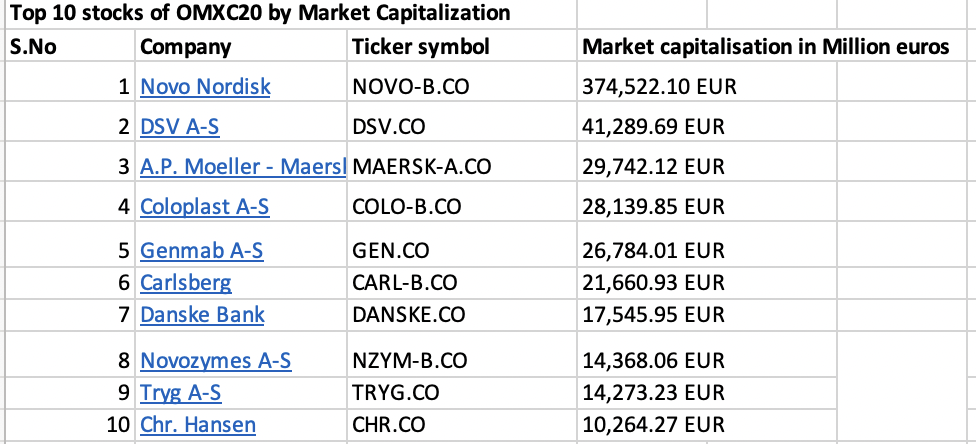
Source: computation by the author (data: Yahoo! Finance website).
Table 2 below gives the sector representation of the OMXC 25 index in terms of number of stocks and market capitalization as of January 31, 2023.
Table 2. Sector representation in the OMXC 25 index.
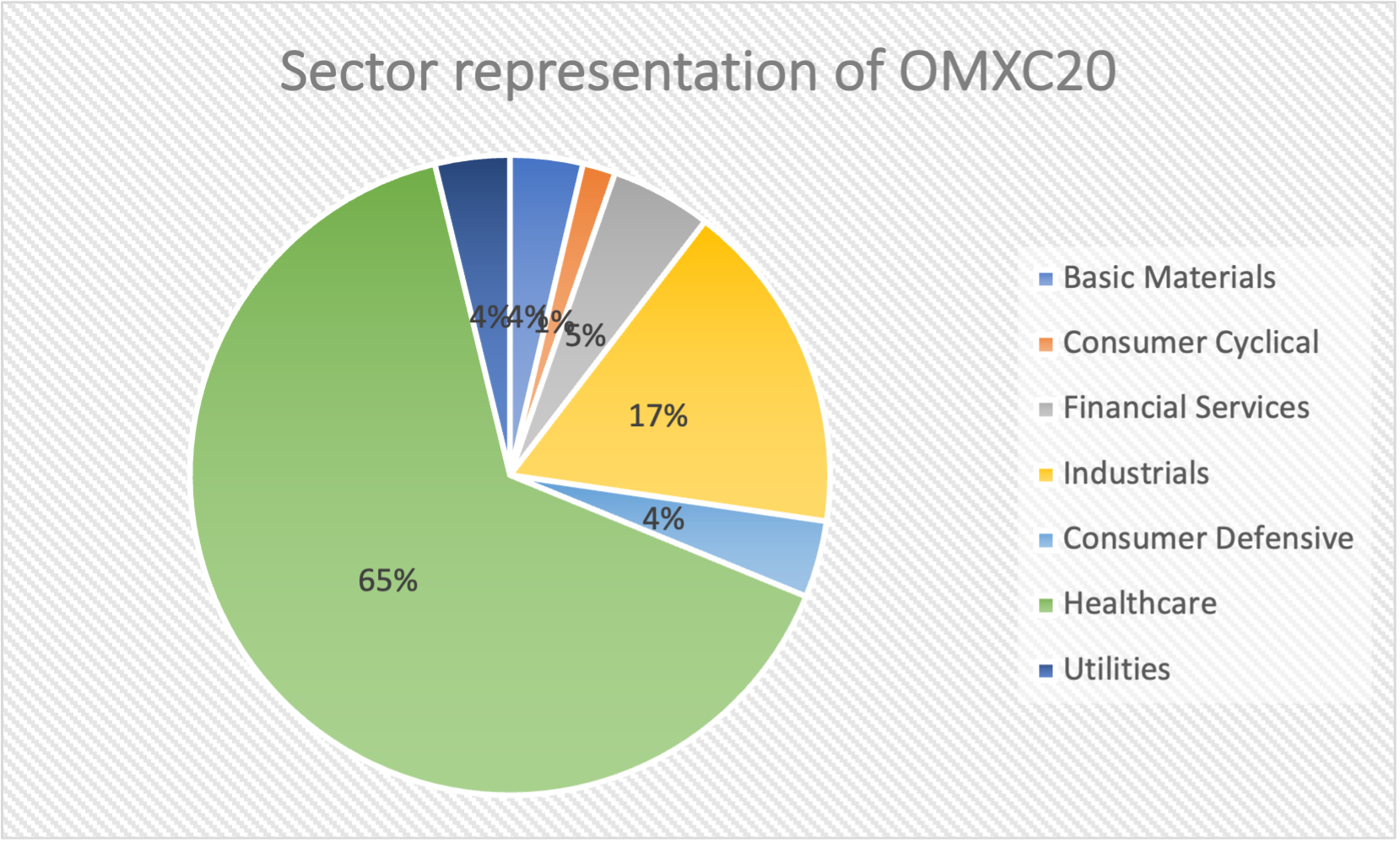
Source: computation by the author (data: Yahoo! Finance website).
Calculation of the OMXC 25 index value
The performance of the 25 most actively traded and highly capitalized companies listed on the Danish Nasdaq Copenhagen stock exchange is reflected in the OMX Copenhagen 25 (OMXC 25) index, which is a float-adjusted market-capitalization-weighted index. The index is evaluated twice a year by Nasdaq Copenhagen and includes businesses from a variety of industries, including technology, healthcare, and finance. Each year, the index is rebalanced in June and December, and the companies that make up the index are chosen using criteria like market capitalization, trading volume, and free float.
The formula to compute the OMXC 25 index is given by
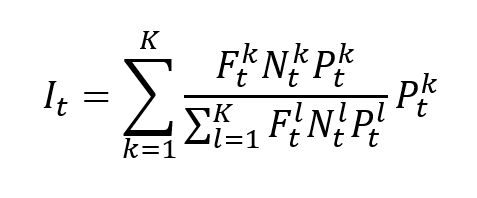
where I is the index value, k a given asset, K the number of assets in the index, Pk the market price of asset k, Nk the number of issued shares for asset k, Fk the float factor of asset k, and t the time of calculation of the index.
In a float-adjusted market-capitalization-weighted index, the weight of asset k is given by
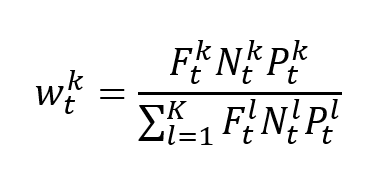
Use of the OMXC 25 index in asset management
A common benchmark used by investors to evaluate the performance of their investment portfolios in relation to the Danish stock market is the OMXC 25 index. Investors and analysts can learn a lot about the state of the Danish economy overall and the performance of important industries like technology, healthcare, and industrials by closely following the changes in the OMXC 25 index. Through ticker symbols like “OMXC25” or “OMXC25.CO,” the index is frequently mentioned in financial news outlets and is readily available to investors and traders worldwide.
Benchmark for equity funds
The performance of the top 25 companies listed on the Copenhagen Stock Exchange (Nasdaq Copenhagen) is represented by the OMXC 25 index, but it does not fully represent the size of the Danish equity market. Because of this, investors seeking a more thorough representation of the Danish market may want to think about other, wider market indices, like the OMXC 25 or the OMXC All-Share.
The 25 most active and liquid companies listed on Nasdaq Copenhagen are included in the OMXC 25 index, which offers a more comprehensive view of the Danish market. The OMXC All-Share index, on the other hand, provides a more thorough overview of the Danish equity market as a whole and covers a wider range of companies, including both large and small caps. In order to accurately track their performance and align it with their investment goals in the Danish market, investors should carefully assess their investment objectives and strategies to determine the most appropriate benchmark index.
Financial products around the OMXC 25 index
With the help of the OMXC 25 index, these financial products give investors the chance to diversify their portfolios, get exposure to the Danish stock market, and perhaps even profit from market fluctuations.
Some of the main financial products associated with the OMXC 25 index are:
- Exchange-Traded Funds (ETFs): ETFs, which are traded on stock exchanges like individual stocks, allow investors access to the OMXX 25 index. ETFs that track the performance of the OMXC 25 index, like the iShares OMXC 25 UCITS ETF and the Xact OMXC 25 ETF, give investors a broad view of the Danish market.
- Options and Futures Contracts: Investors can purchase or sell the OMXC 25 index through options and futures contracts that are linked to the index at a specified price and future date. These derivative contracts can be used for hedging, speculation, and portfolio management, among other things.
- Mutual Funds and Index Funds: A few mutual funds and index funds concentrate their investments in businesses that are part of the OMXX 25 index or seek to match its performance. With the help of these funds, investors now have an easy way to expose themselves to a diverse portfolio of Danish stocks.
Historical data for the OMXC 25 index
How to get the data?
The OMXC 25 index is the most common index used in finance, and historical data for the OMXC 25 index can be easily downloaded from the internet.
For example, you can download data for the OMXC 25 index from December 19, 2016 on Yahoo! Finance (the Yahoo! code for OMXC 25 index is ^OMXC25).
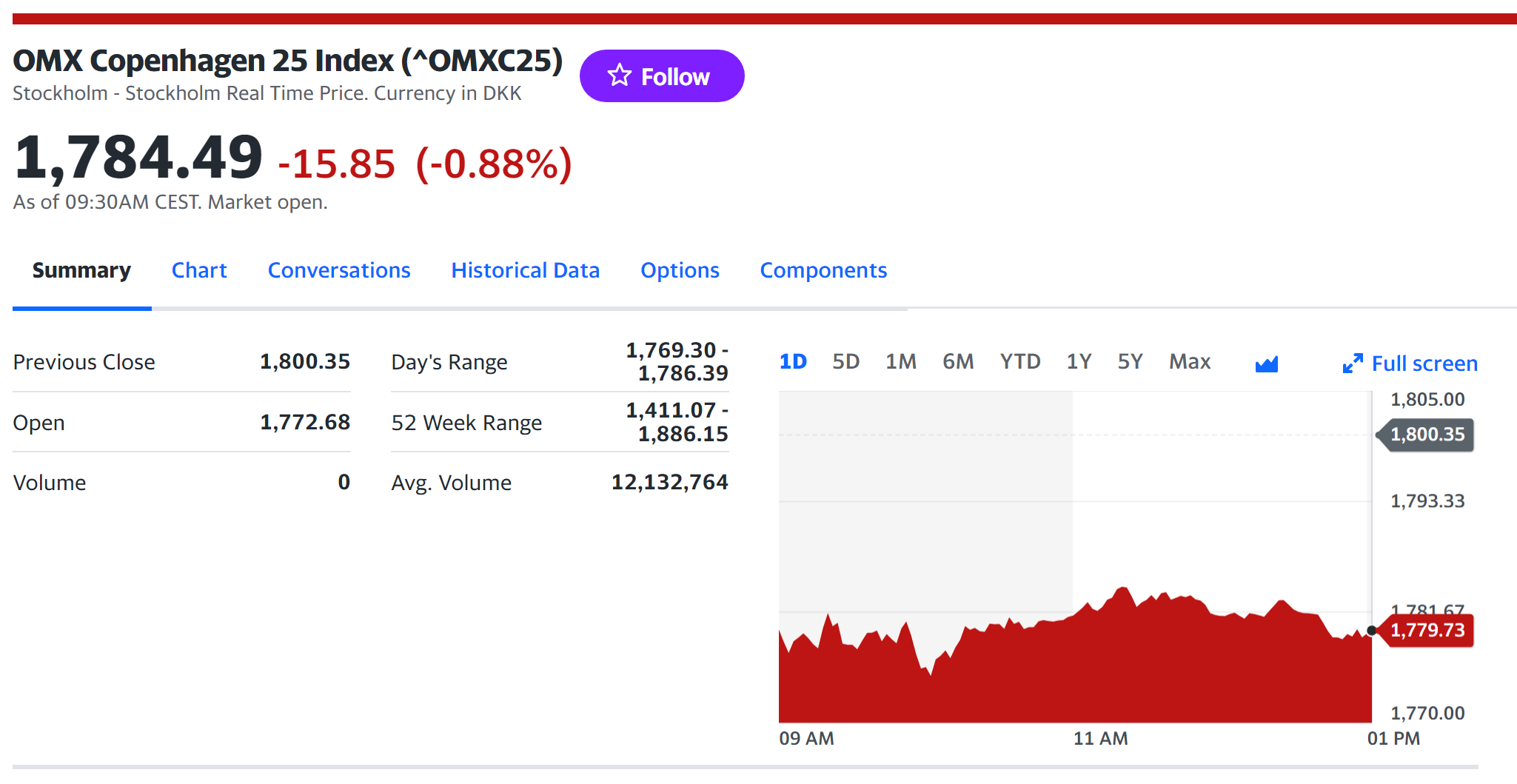
Source: Yahoo! Finance.
You can also download the same data from a Bloomberg terminal.
R program
The R program below written by Shengyu ZHENG allows you to download the data from Yahoo! Finance website and to compute summary statistics and risk measures about the OMXC 25 index.
Data file
The R program that you can download above allows you to download the data for the OMXC 25 index from the Yahoo! Finance website. The database starts on December 19, 2016. It also computes the returns (logarithmic returns) from closing prices.
Table 3 below represents the top of the data file for the OMXC 25 index downloaded from the Yahoo! Finance website with the R program.
Table 3. Top of the data file for the OMXC 25 index.
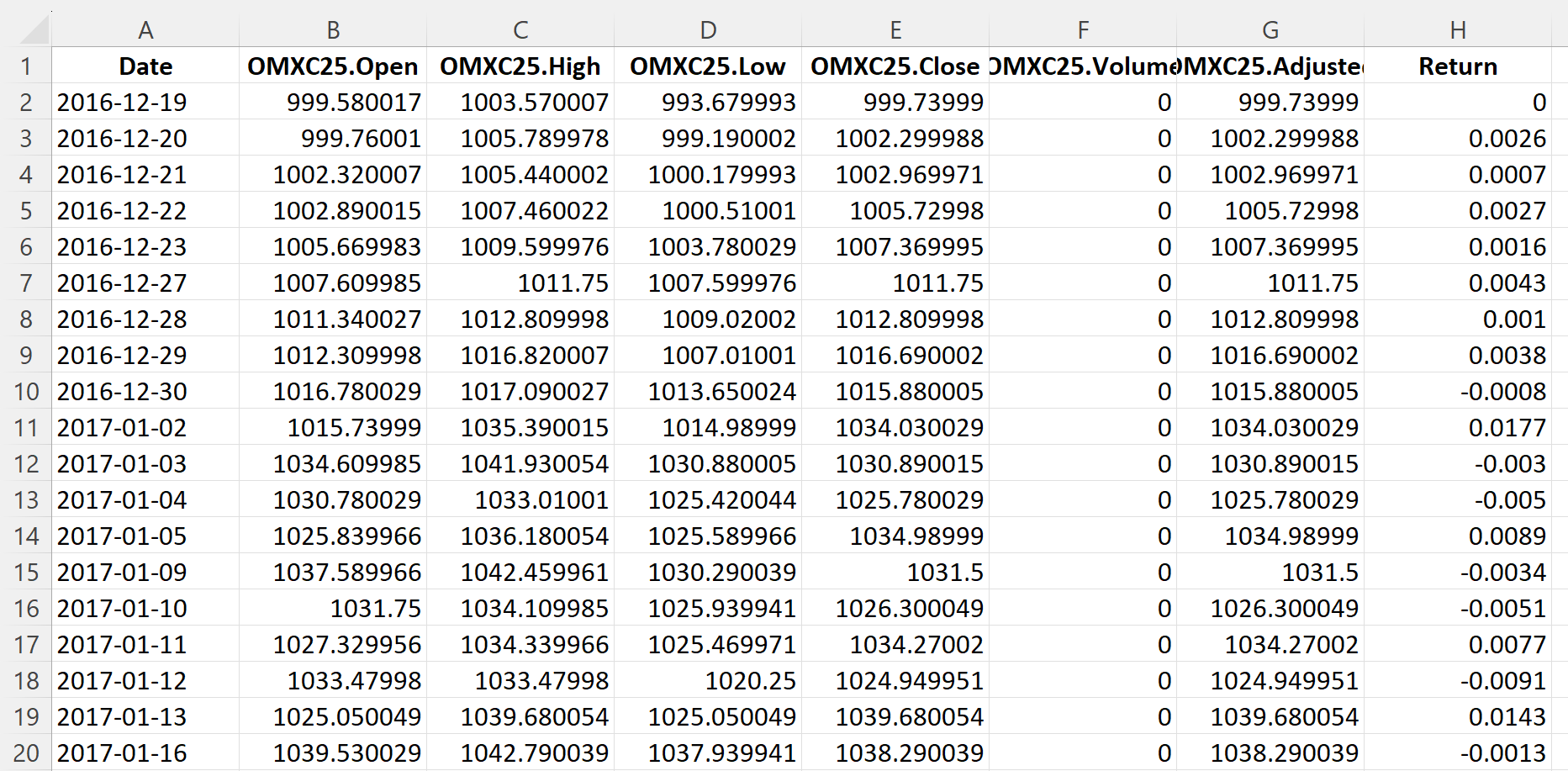
Source: computation by the author (data: Yahoo! Finance website).
Evolution of the OMXC 25 index
Figure 1 below gives the evolution of the OMXC 25 index from December 19, 2016 to December 30, 2022 on a daily basis.
Figure 1. Evolution of the OMXC 25 index.
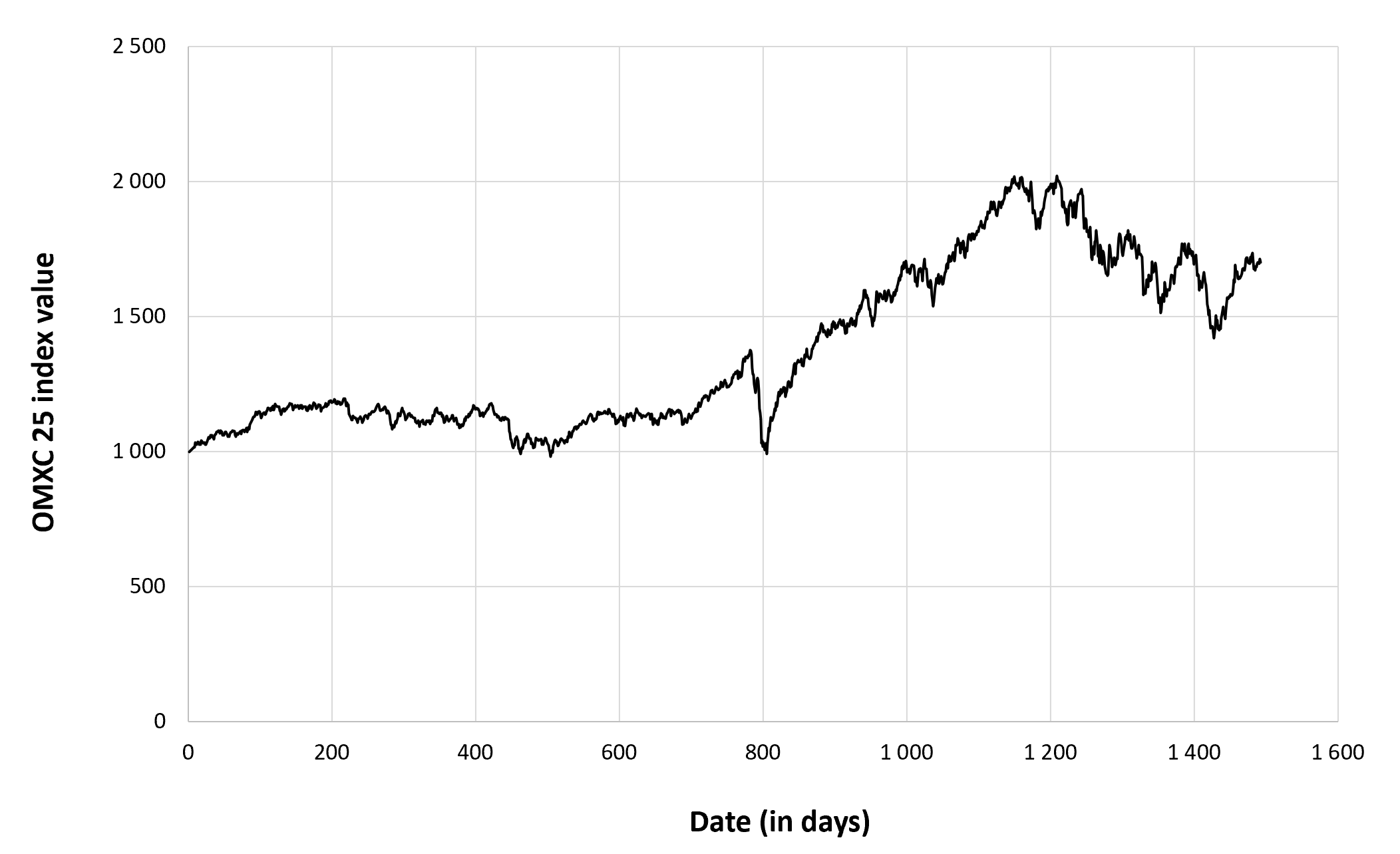
Source: computation by the author (data: Yahoo! Finance website).
Figure 2 below gives the evolution of the OMXC 25 index returns from December 19, 2016 to December 30, 2022 on a daily basis.
Figure 2. Evolution of the OMXC 25 index returns.
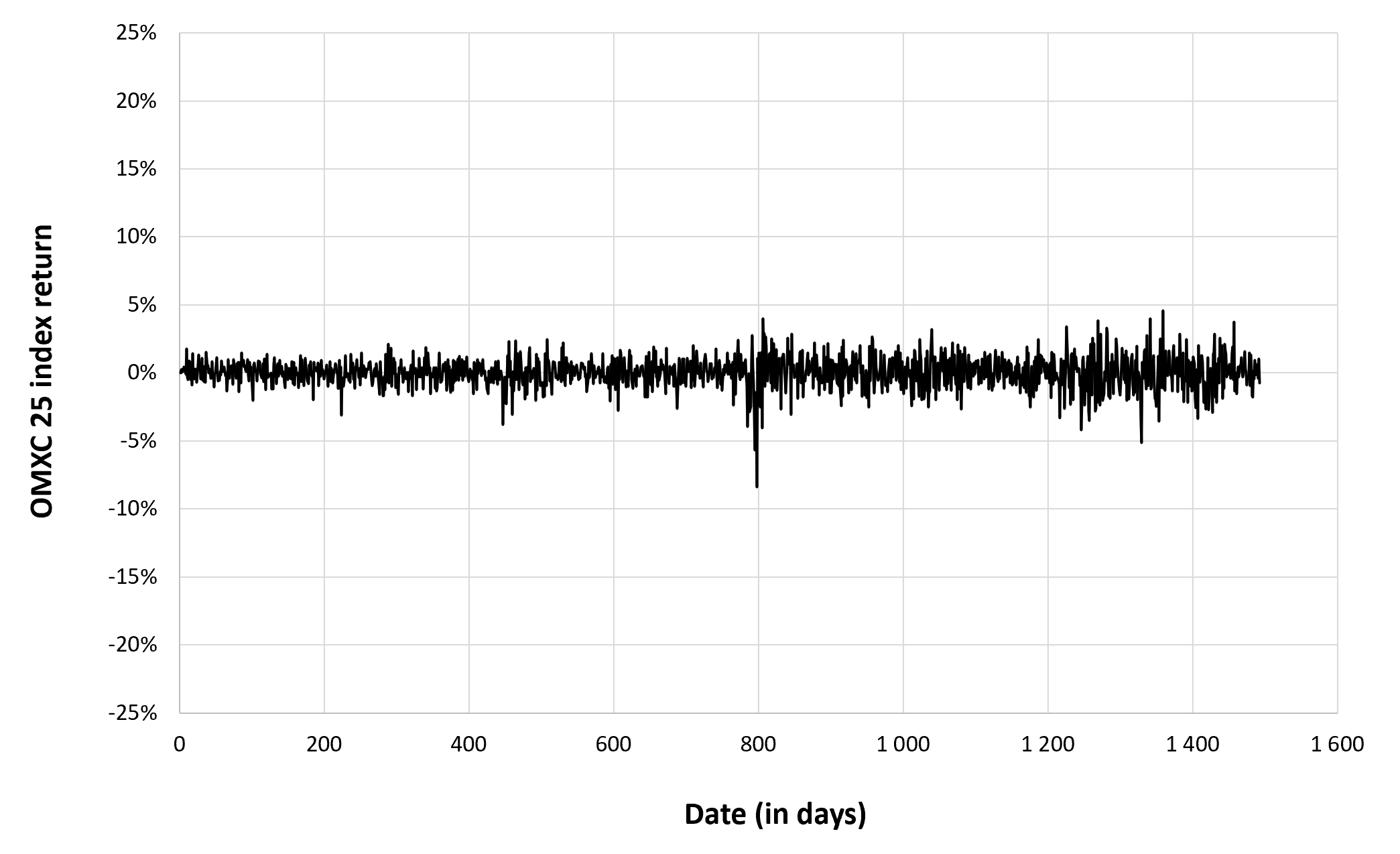
Source: computation by the author (data: Yahoo! Finance website).
Summary statistics for the OMXC 25 index
The R program that you can download above also allows you to compute summary statistics about the returns of the OMXC 25 index.
Table 4 below presents the following summary statistics estimated for the OMXC 25 index:
- The mean
- The standard deviation (the squared root of the variance)
- The skewness
- The kurtosis.
The mean, the standard deviation / variance, the skewness, and the kurtosis refer to the first, second, third and fourth moments of statistical distribution of returns respectively.
Table 4. Summary statistics for the OMXC 25 index.
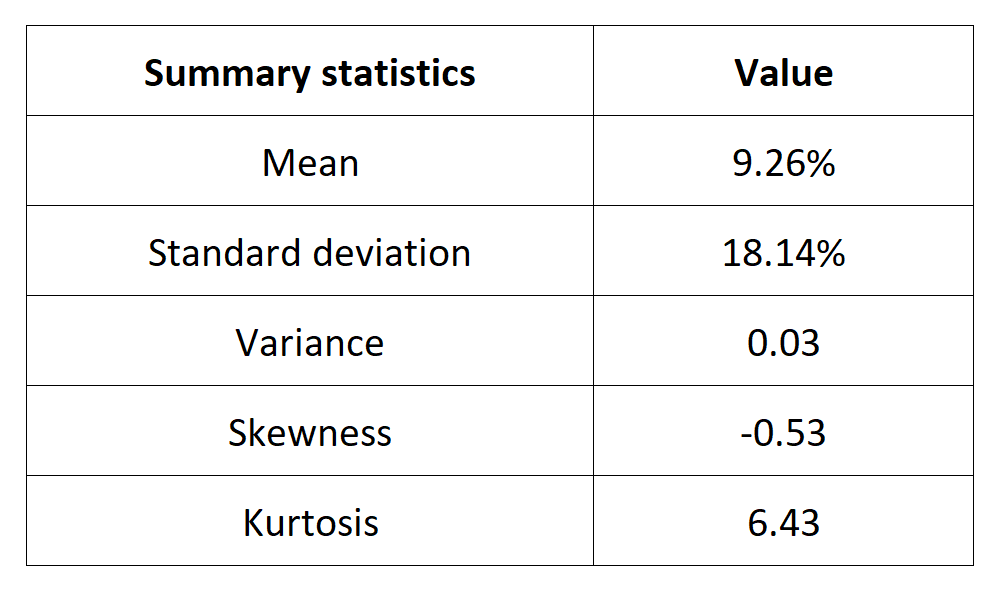
Source: computation by the author (data: Yahoo! Finance website).
Statistical distribution of the OMXC 25 index returns
Historical distribution
Figure 3 represents the historical distribution of the OMXC 25 index daily returns for the period from December 19, 2016 to December 30, 2022.
Figure 3. Historical distribution of the OMXC 25 index returns.
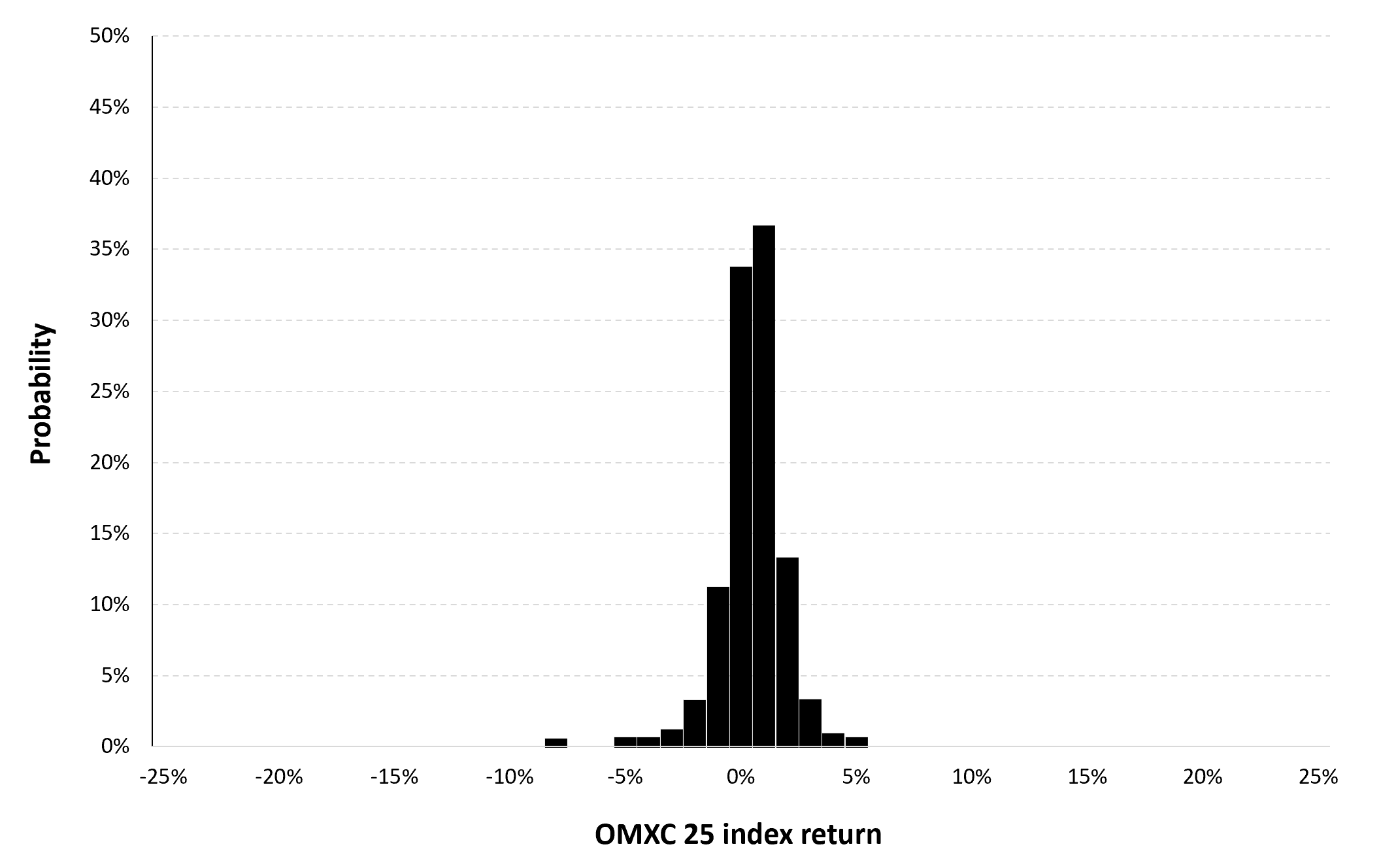
Source: computation by the author (data: Yahoo! Finance website).
Gaussian distribution
The Gaussian distribution (also called the normal distribution) is a parametric distribution with two parameters: the mean and the standard deviation of returns. We estimated these two parameters over the period from December 19, 2016 to December 30, 2022. The mean of daily returns is equal to 0.02% and the standard deviation of daily returns is equal to 1.37% (or equivalently 3.94% for the annual mean and 28.02% for the annual standard deviation as shown in Table 3 above).
Figure 4 below represents the Gaussian distribution of the OMXC 25 index daily returns with parameters estimated over the period from December 19, 2016 to December 30, 2022.
Figure 4. Gaussian distribution of the OMXC 25 index returns.
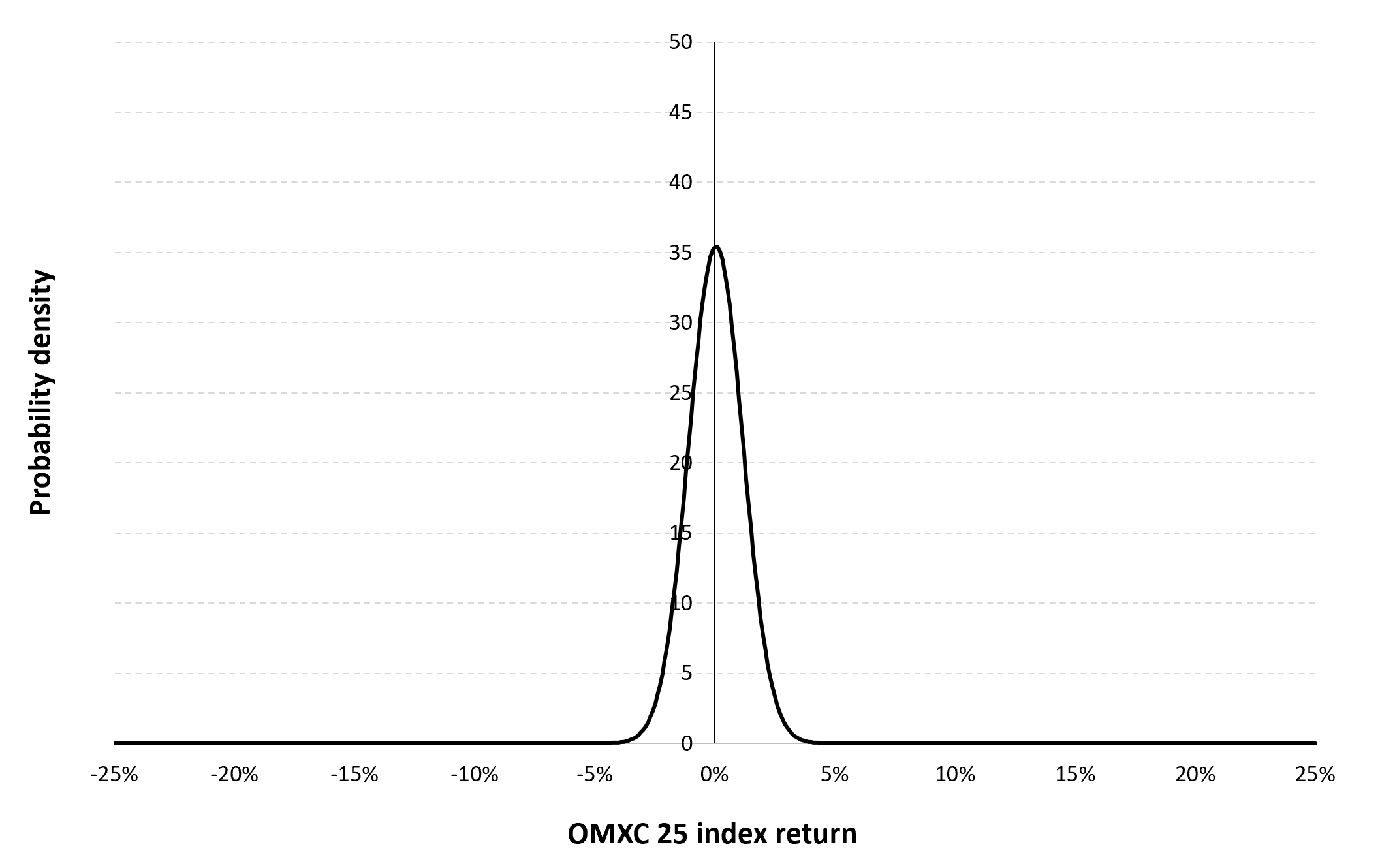
Source: computation by the author (data: Yahoo! Finance website).
Risk measures of the OMXC 25 index returns
The R program that you can download above also allows you to compute risk measures about the returns of the OMXC 25 index.
Table 5 below presents the following risk measures estimated for the OMXC 25 index:
- The long-term volatility (the unconditional standard deviation estimated over the entire period)
- The short-term volatility (the standard deviation estimated over the last three months)
- The Value at Risk (VaR) for the left tail (the 5% quantile of the historical distribution)
- The Value at Risk (VaR) for the right tail (the 95% quantile of the historical distribution)
- The Expected Shortfall (ES) for the left tail (the average loss over the 5% quantile of the historical distribution)
- The Expected Shortfall (ES) for the right tail (the average loss over the 95% quantile of the historical distribution)
- The Stress Value (SV) for the left tail (the 1% quantile of the tail distribution estimated with a Generalized Pareto distribution)
- The Stress Value (SV) for the right tail (the 99% quantile of the tail distribution estimated with a Generalized Pareto distribution)
Table 5. Risk measures for the OMXC 25 index.
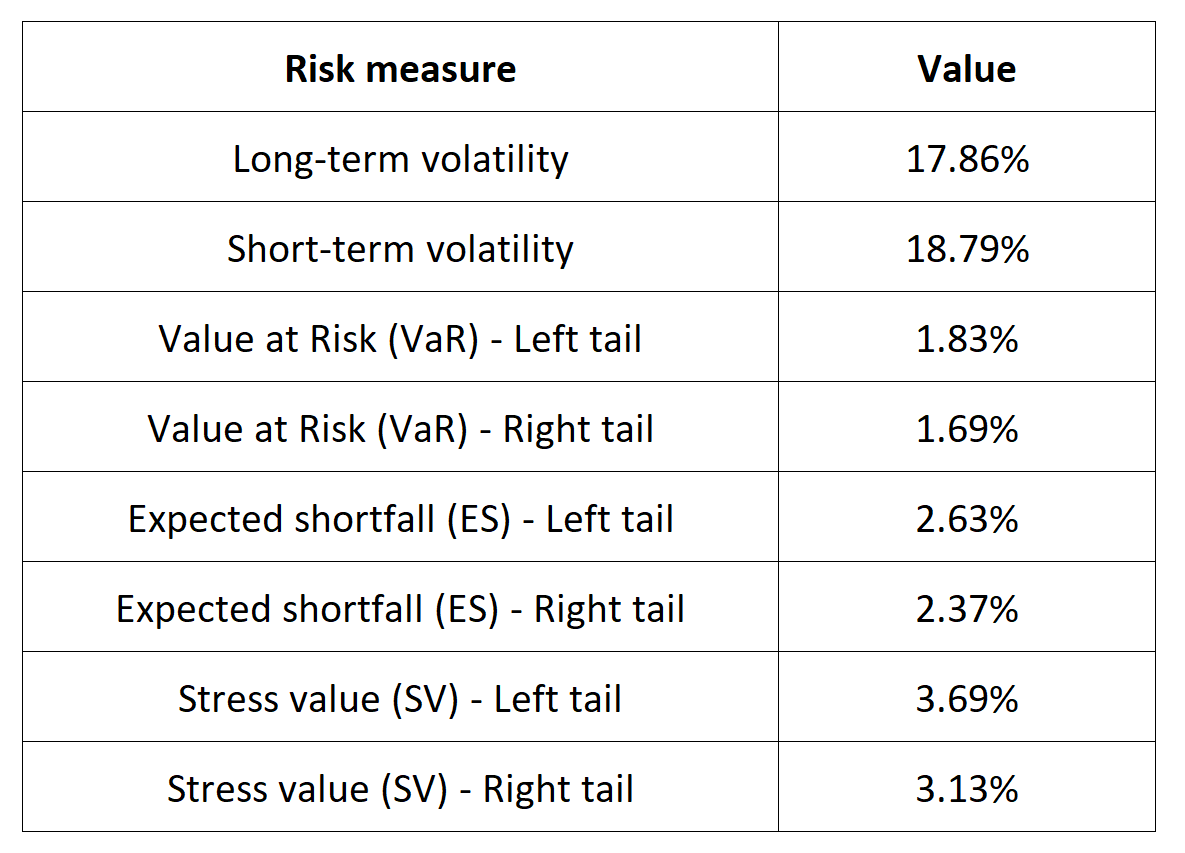
Source: computation by the author (data: Yahoo! Finance website).
The volatility is a global measure of risk as it considers all the returns. The Value at Risk (VaR), Expected Shortfall (ES) and Stress Value (SV) are local measures of risk as they focus on the tails of the distribution. The study of the left tail is relevant for an investor holding a long position in the OMXC 25 index while the study of the right tail is relevant for an investor holding a short position in the OMXC 25 index.
Why should I be interested in this post?
Students can gain a thorough understanding of industry dynamics, market competition, and the interplay of various factors that affect business success in Denmark by studying the OMXC 25 index. Investors can compare the performance of their portfolios to that of the larger Danish stock market using the OMXC 25 index as a benchmark. In addition to reflecting investor sentiment toward Denmark’s biggest and most actively traded companies, it offers a snapshot of the market’s health.
Related posts on the SimTrade blog
About financial indexes
▶ Nithisha CHALLA Financial indexes
▶ Nithisha CHALLA Calculation of financial indexes
▶ Nithisha CHALLA The business of financial indexes
▶ Nithisha CHALLA Float
Other financial indexes
▶ Nithisha CHALLA The S&P 500 index
▶ Nithisha CHALLA The FTSE 100 index
▶ Nithisha CHALLA The DAX 30 index
▶ Nithisha CHALLA The CAC 40 index
About portfolio management
▶ Youssef LOURAOUI Portfolio
▶ Jayati WALIA Returns
About statistics
▶ Shengyu ZHENG Moments de la distribution
▶ Shengyu ZHENG Mesures de risques
Useful resources
Academic research about risk
Longin F. (2000) From VaR to stress testing: the extreme value approach Journal of Banking and Finance, N°24, pp 1097-1130.
Longin F. (2016) Extreme events in finance: a handbook of extreme value theory and its applications Wiley Editions.
About the OMXC 25 index
Nasdaq Index Description
Capital.com What is the OMXC20 index?
Data
Yahoo! Finance Data for the OMXC 25 index
About the author
The article was written in June 2023 by Nithisha CHALLA (ESSEC Business School, Grande Ecole Program – Master in Management, 2021-2023).


